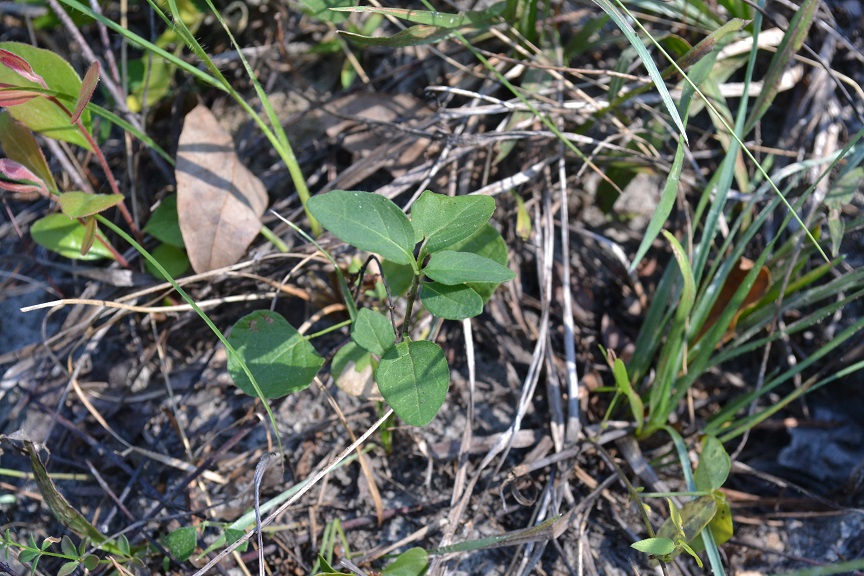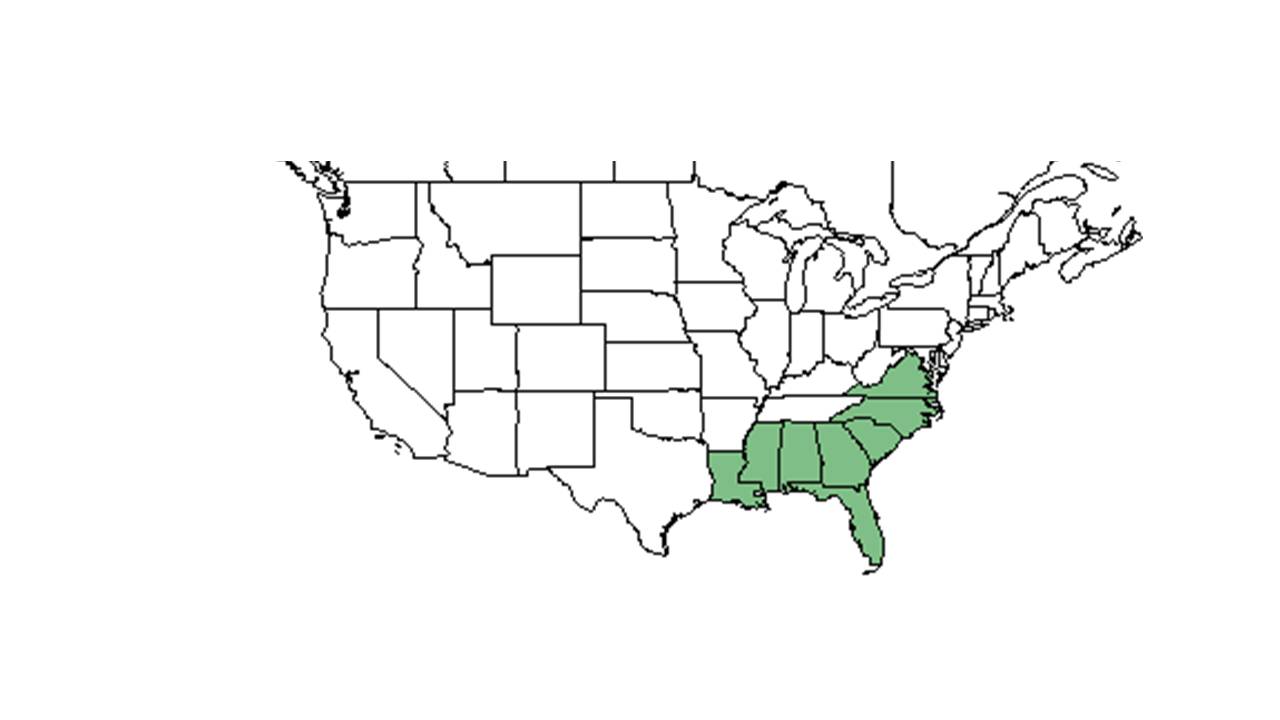Difference between revisions of "Physalis walteri"
| (18 intermediate revisions by 8 users not shown) | |||
| Line 17: | Line 17: | ||
| range_map_caption = Natural range of ''Physalis walteri'' from USDA NRCS [http://plants.usda.gov/core/profile?symbol=PHWA4 Plants Database]. | | range_map_caption = Natural range of ''Physalis walteri'' from USDA NRCS [http://plants.usda.gov/core/profile?symbol=PHWA4 Plants Database]. | ||
}} | }} | ||
| − | Common names: Walter's groundcherry | + | Common names: Walter's groundcherry, dune ground-cherry<ref name=weakley>Weakley, A.S. 2020. Flora of the Southeastern United States. Edition of 20 October 2020. University of North Carolina at Chapel Hill, Chapel Hill, North Carolina.</ref> |
| + | |||
==Taxonomic notes== | ==Taxonomic notes== | ||
| − | Synonyms: ''Physalis | + | Synonyms: ''Physalis walteri'' var. ''walteri''<ref name=weakley/> |
| + | |||
| + | Varieties: none<ref name=weakley/> | ||
| + | |||
==Description== | ==Description== | ||
<!-- Basic life history facts such as annual/perrenial, monoecious/dioecious, root morphology, seed type, etc. --> | <!-- Basic life history facts such as annual/perrenial, monoecious/dioecious, root morphology, seed type, etc. --> | ||
| + | ''P. walteri'' is a rhizomatous perennial. The leaves are ovate, elliptic, obovate or spatulate, 2-10× as long as wide, and stellate pubescent. The flowers are 1 per leaf axil while the berries have flattened, reniform seeds only.<ref name=weakley/> | ||
==Distribution== | ==Distribution== | ||
| + | ''P. walteri'' ranges from southeastern Virginia to southern Florida and west to Mississippi.<ref name=weakley/> | ||
| + | |||
==Ecology== | ==Ecology== | ||
===Habitat=== <!--Natural communities, human disturbed habitats, topography, hydrology, soils, light, fire regime requirements for removal of competition, etc.--> | ===Habitat=== <!--Natural communities, human disturbed habitats, topography, hydrology, soils, light, fire regime requirements for removal of competition, etc.--> | ||
| − | ''P. walteri'' has been observed to be growing naturally on beach dunes and back dunes, in longleaf pine flatwoods, turkey oak sandridges, sandy banks bordering salt marhes,longleaf pine/wiregrass uplands, and slash pine flatwoods. <ref name="FSU Herbarium">Florida State University Robert K. Godfrey Herbarium database. URL: [http://herbarium.bio.fsu.edu http://herbarium.bio.fsu.edu]. Last accessed: July 2015. Collectors: M Y Menzel, R W Menzel, Loran C. Anderson, James R. Burkhalter, Robert K. Godfrey, O. Lakela, William Lindsey, J. B. Nelson, R. H. Wnek, C. Jackson, Robert L. Lazor, Andre F. Clewell, Robert Kral, George R. Cooley, R. J. Eaton, Sidney McDaniel, Cecil R Slaughter, Marc Minno, James D. Ray, Jr., C. E. Wood, C. E. Smith, R. D. Houk, Ann F. Johnson, M. Davis, Richard R. Clinebell II, D. E. Etles, M. S. Etles, William Lindsey, A. H. Curtiss, D. B. Ward, D. Burch. States and Counties: Florida: Brevard, Broward, Calhoun, Citrus, Collier, Dade, Duval, Escambia, Flagler, Franklin, Hernando, Holmes, Jefferson, Leon, Levy, Martin, Monroe, Nassau, Palm Beach, Pinellas, Orange, Santa Rosa, St. Johns, St. Lucie, Seminole, Suwannee, Taylor, Volusia, Wakulla. Georgia: Thomas. Compiled by Tall Timbers Research Station and Land Conservancy.</ref> It has been seen in human disturbed areas such as pine plantations, old fields, plowed lots, vacant lots, roadsides near beaches, roadside ditches, pastures and levees, lawns, and clearing of a swamp forest. <ref name="FSU Herbarium"/> The soil type associated with ''P | + | ''P. walteri'' has been observed to be growing naturally on beach dunes and back dunes, in longleaf pine flatwoods, turkey oak sandridges, sandy banks bordering salt marhes,longleaf pine/wiregrass uplands, and slash pine flatwoods.<ref name="FSU Herbarium">Florida State University Robert K. Godfrey Herbarium database. URL: [http://herbarium.bio.fsu.edu http://herbarium.bio.fsu.edu]. Last accessed: July 2015. Collectors: M Y Menzel, R W Menzel, Loran C. Anderson, James R. Burkhalter, Robert K. Godfrey, O. Lakela, William Lindsey, J. B. Nelson, R. H. Wnek, C. Jackson, Robert L. Lazor, Andre F. Clewell, Robert Kral, George R. Cooley, R. J. Eaton, Sidney McDaniel, Cecil R Slaughter, Marc Minno, James D. Ray, Jr., C. E. Wood, C. E. Smith, R. D. Houk, Ann F. Johnson, M. Davis, Richard R. Clinebell II, D. E. Etles, M. S. Etles, William Lindsey, A. H. Curtiss, D. B. Ward, D. Burch. States and Counties: Florida: Brevard, Broward, Calhoun, Citrus, Collier, Dade, Duval, Escambia, Flagler, Franklin, Hernando, Holmes, Jefferson, Leon, Levy, Martin, Monroe, Nassau, Palm Beach, Pinellas, Orange, Santa Rosa, St. Johns, St. Lucie, Seminole, Suwannee, Taylor, Volusia, Wakulla. Georgia: Thomas. Compiled by Tall Timbers Research Station and Land Conservancy.</ref> It has been seen in human disturbed areas such as pine plantations, old fields, plowed lots, vacant lots, roadsides near beaches, roadside ditches, pastures and levees, lawns, and clearing of a swamp forest.<ref name="FSU Herbarium"/> The soil type associated with ''P. walteri'' includes dry loamy sand, loamy sand, and calcerous soils (such as limerock).<ref name="FSU Herbarium"/> Associated species include ''Tragia smallii, Pinus palustris, Physalis arenicola, Lobelia puberula, Quercus laevis, Sporobolus, Serenoa repens, Yucca, Lyonia, Lantana, Camara, Carex hyalinolepis, Melica mutica, Aristida, Pinus elliottii'', and ''Helianthus debilis.''<ref name="FSU Herbarium"/> |
| + | |||
| + | ''Physalis walteri'' is an indicator species for the North Florida Subxeric Sandhills community type as described in Carr et al. (2010).<ref>Carr, S.C., K.M. Robertson, and R.K. Peet. 2010. A vegetation classification of fire-dependent pinelands of Florida. Castanea 75:153-189.</ref> | ||
| + | |||
===Phenology=== <!--Timing off flowering, fruiting, seed dispersal, and environmental triggers. Cite PanFlora website if appropriate: http://www.gilnelson.com/PanFlora/ --> | ===Phenology=== <!--Timing off flowering, fruiting, seed dispersal, and environmental triggers. Cite PanFlora website if appropriate: http://www.gilnelson.com/PanFlora/ --> | ||
| − | ''P. walteri'' | + | ''P. walteri'' flowers from May through September.<ref name=weakley/> |
===Seed dispersal=== | ===Seed dispersal=== | ||
| − | This species is thought to be dispersed by consumption by vertebrates. <ref>Kirkman, L. Katherine. Unpublished database of seed dispersal mode of plants found in Coastal Plain longleaf pine-grasslands of the Jones Ecological Research Center, Georgia.</ref> | + | This species is thought to be dispersed by consumption by vertebrates.<ref>Kirkman, L. Katherine. Unpublished database of seed dispersal mode of plants found in Coastal Plain longleaf pine-grasslands of the Jones Ecological Research Center, Georgia.</ref> |
<!--===Seed bank and germination===--> | <!--===Seed bank and germination===--> | ||
| − | + | ||
| + | ===Fire ecology=== <!--Fire tolerance, fire dependence, adaptive fire responses--> | ||
| + | Populations of ''Physalis walteri'' have been known to persist through repeated annual burns.<ref>Robertson, K.M. Unpublished data collected from Pebble Hill Fire Plots, Pebble Hill Plantation, Thomasville, Georgia.</ref><ref>Platt, W.J., R. Carter, G. Nelson, W. Baker, S. Hermann, J. Kane, L. Anderson, M. Smith, K. Robertson. 2021. Unpublished species list of Wade Tract old-growth longleaf pine savanna, Thomasville, Georgia.</ref> | ||
<!--===Pollination===--> | <!--===Pollination===--> | ||
| − | <!--=== | + | <!--===Herbivory and toxicology===--> <!--Common herbivores, granivory, insect hosting, poisonous chemicals, allelopathy, etc--> |
<!--===Diseases and parasites===--> | <!--===Diseases and parasites===--> | ||
| − | ==Conservation and | + | ==Conservation, cultivation, and restoration== |
| + | |||
| + | ==Cultural use== | ||
| + | The fruit can be used a substitute for tomatoes.<ref> Fernald, et al. 1958. Edible Plants of Eastern North America. Harper and Row Publishers, New York.</ref> | ||
| − | |||
==Photo Gallery== | ==Photo Gallery== | ||
<gallery widths=180px> | <gallery widths=180px> | ||
Latest revision as of 15:25, 19 June 2023
| Physalis walteri | |
|---|---|

| |
| Photo taken by Kevin Robertson | |
| Scientific classification | |
| Kingdom: | Plantae |
| Division: | Magnoliophyta - Flowering plants |
| Class: | Magnoliopsida – Dicotyledons |
| Order: | Solanales |
| Family: | Solanaceae |
| Genus: | Physalis |
| Species: | P. walteri |
| Binomial name | |
| Physalis walteri Nutt. | |

| |
| Natural range of Physalis walteri from USDA NRCS Plants Database. | |
Common names: Walter's groundcherry, dune ground-cherry[1]
Contents
Taxonomic notes
Synonyms: Physalis walteri var. walteri[1]
Varieties: none[1]
Description
P. walteri is a rhizomatous perennial. The leaves are ovate, elliptic, obovate or spatulate, 2-10× as long as wide, and stellate pubescent. The flowers are 1 per leaf axil while the berries have flattened, reniform seeds only.[1]
Distribution
P. walteri ranges from southeastern Virginia to southern Florida and west to Mississippi.[1]
Ecology
Habitat
P. walteri has been observed to be growing naturally on beach dunes and back dunes, in longleaf pine flatwoods, turkey oak sandridges, sandy banks bordering salt marhes,longleaf pine/wiregrass uplands, and slash pine flatwoods.[2] It has been seen in human disturbed areas such as pine plantations, old fields, plowed lots, vacant lots, roadsides near beaches, roadside ditches, pastures and levees, lawns, and clearing of a swamp forest.[2] The soil type associated with P. walteri includes dry loamy sand, loamy sand, and calcerous soils (such as limerock).[2] Associated species include Tragia smallii, Pinus palustris, Physalis arenicola, Lobelia puberula, Quercus laevis, Sporobolus, Serenoa repens, Yucca, Lyonia, Lantana, Camara, Carex hyalinolepis, Melica mutica, Aristida, Pinus elliottii, and Helianthus debilis.[2]
Physalis walteri is an indicator species for the North Florida Subxeric Sandhills community type as described in Carr et al. (2010).[3]
Phenology
P. walteri flowers from May through September.[1]
Seed dispersal
This species is thought to be dispersed by consumption by vertebrates.[4]
Fire ecology
Populations of Physalis walteri have been known to persist through repeated annual burns.[5][6]
Conservation, cultivation, and restoration
Cultural use
The fruit can be used a substitute for tomatoes.[7]
Photo Gallery
References and notes
- ↑ 1.0 1.1 1.2 1.3 1.4 1.5 Weakley, A.S. 2020. Flora of the Southeastern United States. Edition of 20 October 2020. University of North Carolina at Chapel Hill, Chapel Hill, North Carolina.
- ↑ 2.0 2.1 2.2 2.3 Florida State University Robert K. Godfrey Herbarium database. URL: http://herbarium.bio.fsu.edu. Last accessed: July 2015. Collectors: M Y Menzel, R W Menzel, Loran C. Anderson, James R. Burkhalter, Robert K. Godfrey, O. Lakela, William Lindsey, J. B. Nelson, R. H. Wnek, C. Jackson, Robert L. Lazor, Andre F. Clewell, Robert Kral, George R. Cooley, R. J. Eaton, Sidney McDaniel, Cecil R Slaughter, Marc Minno, James D. Ray, Jr., C. E. Wood, C. E. Smith, R. D. Houk, Ann F. Johnson, M. Davis, Richard R. Clinebell II, D. E. Etles, M. S. Etles, William Lindsey, A. H. Curtiss, D. B. Ward, D. Burch. States and Counties: Florida: Brevard, Broward, Calhoun, Citrus, Collier, Dade, Duval, Escambia, Flagler, Franklin, Hernando, Holmes, Jefferson, Leon, Levy, Martin, Monroe, Nassau, Palm Beach, Pinellas, Orange, Santa Rosa, St. Johns, St. Lucie, Seminole, Suwannee, Taylor, Volusia, Wakulla. Georgia: Thomas. Compiled by Tall Timbers Research Station and Land Conservancy.
- ↑ Carr, S.C., K.M. Robertson, and R.K. Peet. 2010. A vegetation classification of fire-dependent pinelands of Florida. Castanea 75:153-189.
- ↑ Kirkman, L. Katherine. Unpublished database of seed dispersal mode of plants found in Coastal Plain longleaf pine-grasslands of the Jones Ecological Research Center, Georgia.
- ↑ Robertson, K.M. Unpublished data collected from Pebble Hill Fire Plots, Pebble Hill Plantation, Thomasville, Georgia.
- ↑ Platt, W.J., R. Carter, G. Nelson, W. Baker, S. Hermann, J. Kane, L. Anderson, M. Smith, K. Robertson. 2021. Unpublished species list of Wade Tract old-growth longleaf pine savanna, Thomasville, Georgia.
- ↑ Fernald, et al. 1958. Edible Plants of Eastern North America. Harper and Row Publishers, New York.